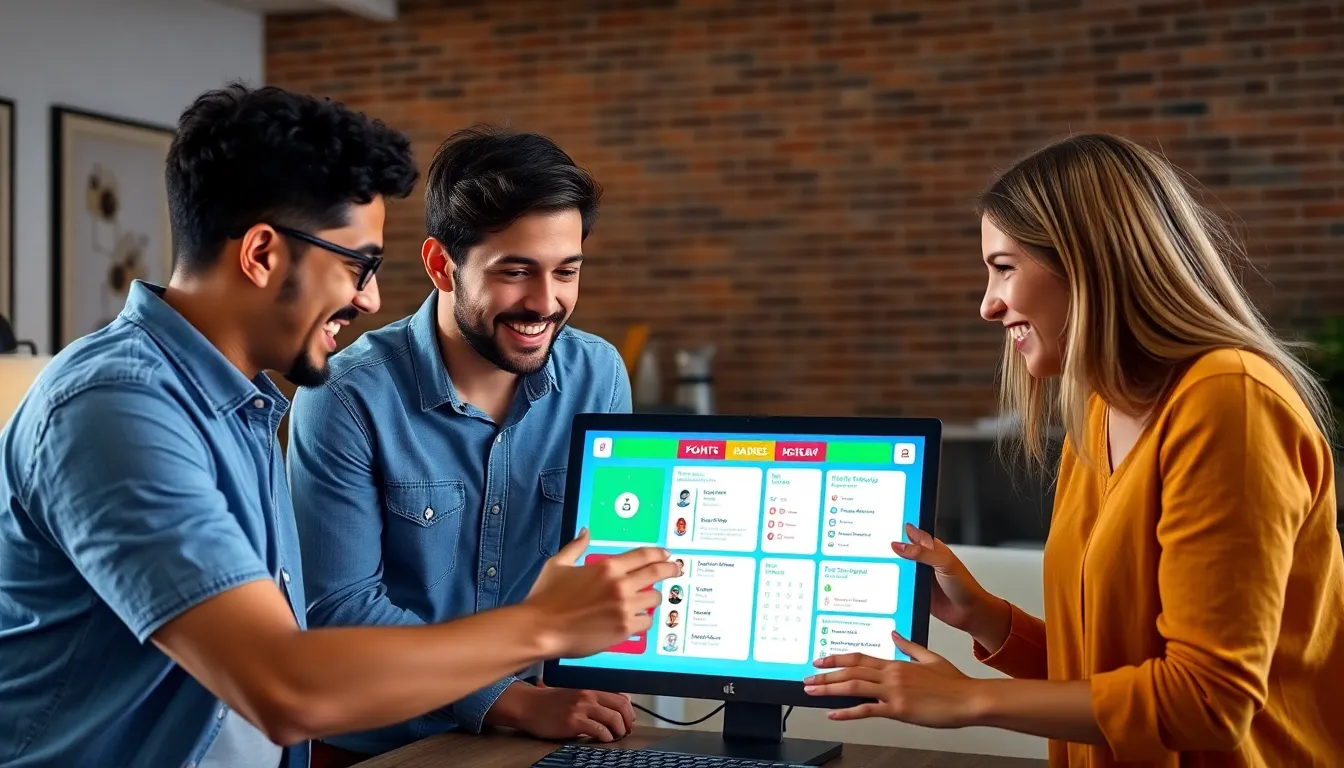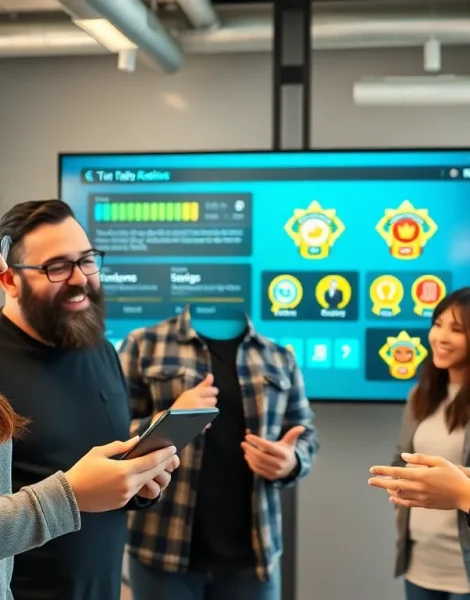In a world where software can sometimes feel as exciting as watching paint dry, gamification swoops in like a superhero with a cape made of pixels. By infusing game-like elements into software, developers are turning mundane tasks into thrilling adventures. Who wouldn’t want to earn points for completing a report or unlock badges for meeting deadlines? It’s like turning work into a playful quest, and let’s face it, who doesn’t want to be the hero of their own productivity saga?
Table of Contents
ToggleOverview of Gamification in Software
Gamification in software involves integrating game mechanics into non-gaming environments to boost user engagement. This approach transforms everyday tasks into enjoyable experiences through elements like points, badges, and leaderboards. Users thrive on competition and achievement, fostering motivation that enhances productivity.
Game-like features captivate users by offering rewards for completing specific activities. Earning points provides immediate satisfaction, while unlocking badges serves as a form of recognition for their efforts. Software incorporating these strategies can foster a sense of accomplishment and community among users.
Applications in various industries show significant improvements in user engagement and retention. For example, educational platforms utilizing gamification techniques report higher completion rates among students. Furthermore, project management tools that employ these elements often see increased productivity, as users aim for rewards while managing tasks.
Research indicates that more than 70% of employees feel more engaged when gamification is present in their work environment. This enhances not just the overall experience but also aligns with company goals. Incorporating feedback loops, where achievements prompt further challenges, creates a continuous cycle of motivation and performance.
Studies demonstrate that gamification not only enhances user enjoyment but also encourages collaboration. When teams compete for top spots on leaderboards, camaraderie grows. This ultimately benefits organizations by creating a more dynamic and productive work culture.
Gamification in software plays a crucial role in enriching user experiences. By implementing game mechanics, companies can elevate user engagement, improve performance, and foster a thriving work environment.
Benefits of Gamification in Software


Gamification in software offers numerous advantages that enhance user experience and productivity.
Enhanced User Engagement
Incorporating game elements significantly boosts user engagement. Points, badges, and leaderboards create a fun atmosphere that invites users to interact more frequently. Users are often motivated by competition and achievement, leading to increased participation. Continuous feedback in these systems keeps users informed about their progress, fostering a sense of accomplishment. Studies show that organizations implementing gamified systems notice a 48% increase in user engagement. This engagement translates to higher retention rates and a vibrant user community within applications.
Motivation and Behavior Change
Gamification effectively drives motivation and influences behavior. By rewarding users for completing tasks, it aligns their efforts with organizational goals. Research indicates that 70% of employees report higher motivation levels when engaging with gamified systems. Users develop a habit of regular participation, improving productivity. Incorporating challenges encourages users to push their limits and embrace new skills. Positive reinforcement motivates ongoing learning and collaboration, contributing to a more dynamic work environment.
Key Elements of Gamification
Gamification in software incorporates several key elements that enhance user engagement through playful interaction. These aspects include points, badges, leaderboards, challenges, and rewards.
Points, Badges, and Leaderboards
Points serve as a tangible representation of user progress and engagement. Users earn them for activities completed, encouraging continued interaction. Badges symbolize achievements, providing visual incentives that users can showcase. Leaderboards create a sense of competition, allowing users to compare their progress with peers. This competitive spirit can drive motivation, as individuals strive to improve their standing. Research shows that 70% of employees become more engaged in environments that utilize these elements. Gamification creates an enjoyable atmosphere where people feel recognized for their achievements while fostering a community dynamic.
Challenges and Rewards
Challenges offer users tasks that encourage personal growth and skill development. These can vary in complexity, catering to different users’ abilities. By incorporating enticing rewards upon completion, systems motivate users to overcome obstacles. Rewards can include points, badges, or access to exclusive content, which provide immediate gratification. The continuous cycle of facing challenges and receiving rewards fosters ongoing participation. Studies indicate that gamification drives motivation, with 70% of employees reporting increased motivation levels. As users remain engaged, they develop a sense of accomplishment and commitment to their tasks, contributing to a thriving work environment.
Examples of Gamification in Software
Numerous software applications successfully incorporate gamification to boost user engagement and motivation. Here are some notable examples that illustrate its impact across various industries.
Successful Case Studies
Duolingo demonstrates gamification well by transforming language learning into a fun experience. Users earn points and virtual rewards for completing lessons, fostering a sense of achievement and encouraging continued participation. Nike+ further enhances motivation by allowing users to track runs and compete in challenges, creating a community among fitness enthusiasts. Salesforce’s Trailhead platform engages users through interactive learning paths, with badges awarded for skill mastery, which boosts user retention and professional development.
Common Applications
Gamification finds extensive use in educational software, project management tools, and employee training programs. Educational platforms often reward students with points and badges for completing assignments, enhancing learning motivation. Project management tools utilize leaderboards to track progress and acknowledge high-performing team members, fostering a healthy competitive spirit. In employee training, companies implement gamified systems to encourage completion of courses, promoting higher retention rates and engagement among staff members.
Challenges and Considerations
Gamification in software presents its own set of challenges and considerations. Understanding these obstacles is crucial for successful implementation.
Design and Implementation Issues
Developing effective gamification requires careful design and implementation. First, designers must align game mechanics with user goals and business objectives. Creating a seamless user experience ensures engagement without overwhelming users. Also, balancing competition and collaboration influences motivation levels. Including diverse rewards can cater to different user preferences. Regularly updating content and challenges keeps the experience fresh, preventing stagnation. Integrating user feedback allows for continuous improvement, ensuring that the gamified system evolves with user needs.
Potential Drawbacks
Despite the advantages, gamification has potential drawbacks. Users may become overly focused on rewards rather than intrinsic motivation. In some cases, excessive competition can lead to stress among participants. If game elements feel forced or misaligned with user expectations, the impact might diminish engagement. Additionally, users may experience fatigue from overly repetitive tasks. Organizations also risk alienating those who don’t engage with gamification. Recognizing these issues upfront helps in crafting a more balanced, effective gamified experience.
Gamification in software development is a powerful tool that transforms traditional tasks into engaging experiences. By incorporating game mechanics like points and badges, it fosters motivation and enhances productivity. Organizations that embrace this approach not only see improved user engagement but also create a dynamic work environment that encourages collaboration and ongoing learning.
However, successful implementation requires thoughtful design to align game elements with user goals. Striking the right balance between competition and collaboration is essential to maintain motivation without overwhelming users. As gamification continues to evolve, its potential to enrich user experiences and drive engagement remains significant in various industries.









